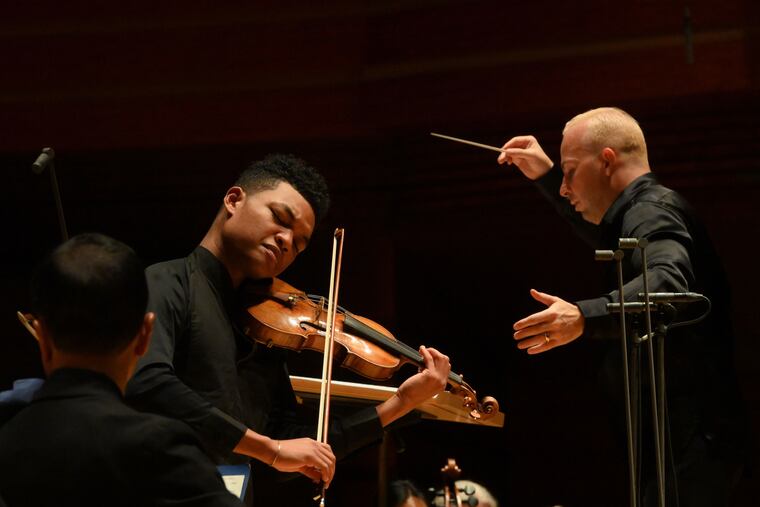With two Florence Price concertos and a charismatic soloist, Philadelphia Orchestra brings a golden glow
It’s heartening that Price, a composer once shut out of the classical establishment because she was Black, now has such a visible advocate.

If orchestras are to thrive, there will be nights when following public taste is the way to go — putting Ravel’s popular La valse on the program, for instance.
Other times, the job is to lead public taste, by presenting new or unknown work you believe in.
The Philadelphia Orchestra attempted to achieve both goals simultaneously on a single program Thursday night, bookending its first-ever performances of two Florence Price violin concertos with La valse and music from Strauss’ Der Rosenkavalier.
Music director Yannick Nézet-Séguin took to the microphone with an artistic rationale, telling the audience that the program (repeated this weekend) made an Old World/New World Europe/America statement. But the argument seemed weak, especially since it was clear that Strauss and Ravel were meant to lure audiences who, even now, may not be familiar with Price’s work.
No other major orchestra is promoting Price the way this one is, and it’s heartening that the composer, once shut out of the classical establishment because she was Black, now has such a visible advocate. The group’s recording of her First and Third symphonies won a Grammy in April — a first Grammy win for the orchestra in the “best orchestral performance” category, and a first-ever Grammy for Nézet-Séguin.
As far as the listening public goes, the rows of empty seats in Verizon Hall Thursday suggested that the orchestra has more evangelizing to do. Sometimes making a big artistic statement — even with an astonishingly good soloist, here Randall Goosby in performances being recorded for commercial release — isn’t enough to make a big splash.
It’s important to remember that although we live in a culture soaked through with a return-on-investment mentality, risk is vital to growth. Price’s singular musical language was once new to these players, and in her music now they routinely turn from carefree to urgent in the most elegant way, as her music does.
Interestingly, the two warhorses — Strauss and Ravel — for all of their noise, made the lesser impact. Nézet-Séguin had some sharp insights in the Ravel, often finding gauzy textures and just the right woozy feeling. Parts of Strauss’ Suite from Der Rosenkavalier were worked out beautifully. But other sections were merely facile. As the leader of a certain opera company 90 miles to the northeast, Nézet-Séguin surely has a more fully individualized interpretation of this operatic work somewhere in his future.
» READ MORE: Pianist Lang Lang opens Philadelphia Orchestra season with a $900K gala and a Disney twist
Price, born in Little Rock in 1887, is undergoing a period of rediscovery that echoes the way the artistic profiles of Bach, Schubert, and Mahler were remade after their deaths by later generations. We still don’t know the full scope of her output. These two violin concertos were among the works found in an abandoned house an hour and a half south of Chicago in 2009.
Listeners will pat themselves on the back for detecting Tchaikovsky’s Violin Concerto woven into Price’s Violin Concerto No. 1 (1939). The resemblances are more than passing; they’re almost like quotes. She’s playing with us, the way Nino Rota referenced Mozart, Tchaikovsky, Brahms, and others in his piano concertos — with a knowing wink.
The main language, though, is unmistakably Price, an expression of Black American musical traditions wrapped in a feeling of ease that she alone owned. Goosby caught this aspect of the music’s character beautifully. There’s a golden glow around this piece, a sense of goodness in the world, for which the violinist and his deft virtuosity and pure sound were a perfect match.
Price’s short Violin Concerto No. 2 (1952) was more forceful, but still good-natured, and in single-movement form had particularly satisfying dialogue between orchestra and soloist.
Her Adoration (originally for organ) made for a lovely encore in Jim Gray’s arrangement for solo violin and strings. Goosby is not only technically impressive, but he also has those rare qualities of a first-class soloist: charisma for days, and the strong point of view of an artist with a distinct voice.
Additional performances: Saturday at 8 p.m. and Sunday at 2 p.m. in Verizon Hall, Broad and Spruce Streets. Tickets are $10-$49. philorch.org, 215-893-1999.